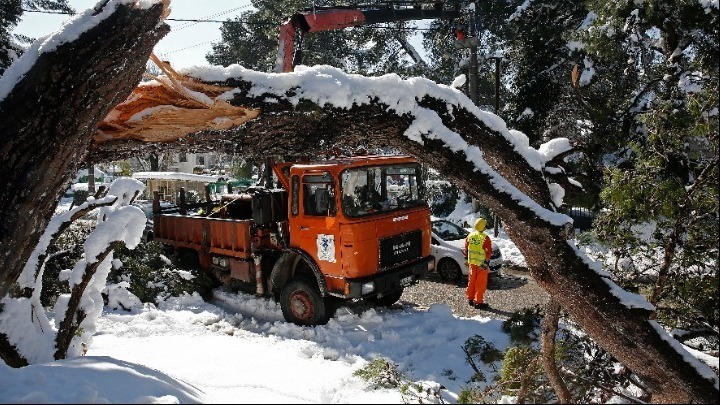Water content in 'Medea' snow contributed to collapse of trees, Nat'l Observatory says

The consistency of water in snow affects its weight and the snow that was dumped in Greece overnight on Monday, Feb. 15 was heavier, causing the collapse of more trees, an analysis of the National Observatory of Athens' Meteo scientists said on Saturday.
The lightest snow of all, "fluffy" or "dry" snow, occurs when the temperatures reach much below zero degrees Celsius. It weighs 4 kg per square meter, Meteo said. Regular snow, in slightly sub-zero temperatures, is triple this weight, at 12 kg/sq.m.
Weighing the heaviest is the snow brought by the "Medea" weather front, which was "wet". Temperatures near the ground reached zero degrees Celsius, the snow contained more water, and it was seven times heavier than fluffy snow, at 30 kg/sq.m, the analysis showed. (All weight comparisons refer to snow 20 cm deep.)
In "Medea's" case, Mt. Pendeli measurements (500 m above sea level) showed that in northern Attica ground-level temperatures were at most -5C in 2002, -10C in 2004, and -2.7C on Tuesday, February 16, the day after the snowstorm.
"The relatively higher temperatures of the recent snowfall related to 'Medea' resulted in greater water content in snowflakes, and therefore a significantly higher weight per surface unit," Meteo said. "Additionally, wet snow cannot be easily swept away by winds near the ground, and wind velocity was much higher in previous snowstorms compared to 'Medea'," it explained.
This parameter of water content and depth of snow should be taken into account when planning ahead, Meteo said, besides other factors affecting temperatures. One thing that would help these calculations is the use of rods measuring the depth of snow, especially in higher elevations where avalanches are possible. Snow depth measuring is currently only being recorded at Mt. Psiloritis on Crete, where data exists for the past three years, it added.

